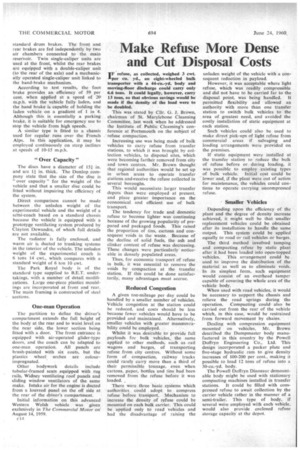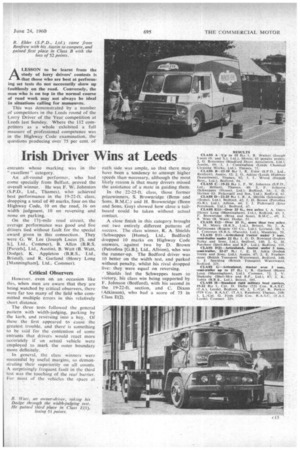Make Refuse More Dense and Cut Disposal Costs
Page 52

Page 53

If you've noticed an error in this article please click here to report it so we can fix it.
IF refuse, as collected, weighed 3 cwt
per cu. yd., an eight-wheeled bulk transporter with a 44-cu.-yd. body and moving-floor discharge could carry only 6.6 tons. It could legally, however, carry 13 tons, so that obvious savings would be made if the density of the toad were to be doubled.
This was stated by Cllr. G. J. Brown, chairman of St. Marylebone Cleansing Committee, last week when he addressed the Institute of Public Cleansing's conference at Portsmouth on the subject of
• refuse compaction.
Increasing use was being made of bulk vehicles to carry refuse from transfer stations, to which it was brought by collection vehicles, to disposal sites, which were becoming farther removed from city and town centres. Mr. Brown thought that regional authorities would be set up in urban areas to operate transfer stations and -receive the refuse collected in several boroughs.
This would necessitate larger transfer depots than were employed at present, and place greater -importance on the economical and efficient use of bulk transport.
The tendency for trade and domestic refuse to become lighter was continuing because of the growing popularity of prepared and packaged foods. This raised the proportion of tins, cartons and consequent voids in the waste. Because of the decline of solid fuels, the ash and clinker content of refuse was decreasing. These changes were particularly noticeable in densely populated areas.
Thus, for economic transport of refuse in bulk, it was essential to remove the voids by compaction at the transfer station. If this could be done satisfactorily, many advantages must accrue,
Reduced Congestion A given ton-mileage per day could be handled by a smaller number of vehicles. Vehicle congestion at the station could be reduced, and costs should be less because fewer vehicles would have to be provided and maintained. Alternatively, smaller vehicles with greater manceuvrability could be employed.
Whilst it was desirable to provide full payloads for bulk vehicles, the .same applied to other methods, such as .rail wagons and barges, of transporting refuse from city centres. Without some form of compaction, railway trucks could rarely carry more than a third of their permissible tonnage, even when cartons, paper, bottles and tins had been removed from the refuse before it was loaded. , There were three basic systems which authorities could adopt to compress refuse before transport.. Mechanism to increase the density of refuse could be mounted on each bulk carrier. This could be applied only to road vehicles and had the disadvantage of raising the unladen weight of the vehicle with a consequent reduction in payload.
However, it was acceptable where light refuse, which was readily compressible and did not have to be carried fat to the disposal point, was being handled. It permitted flexibility and allowed an authority with more than one transfer station to switch bulk vehicles to the area of greatest need, and avoided the costly installation of static equipment at each station.
Such vehicles could also be used to make direct pick-ups of light refuse from commercial areas if salvaging and loading arrangements were provided on the premises.
If static equipment were installed at the transfer station to reduce the bulk of refuse before or during loading, it wks possible to employ existing types of bulk vehicle. Initial cost could be lower and, if the plant were out of action for maintenance, the vehicles could continue to operate carrying uncompressed refuse.
Smaller Vehicles
Depending upon the efficiency of the plant and the degree of density increase achieved, it might well be that smaller replacement vehicles could be obtained after its installation to handle the same output. This system could be applied equally to road or rail vehicles or barges.
The third method involved tamping and compacting refuse by static plant after it had been loaded into open-topped vehicles, This arrangement could be used to improve the distribution of the material as well as to eliminate voids. In its simplest form. such equipment would consist of an overhead tamper capable of covering the whole area of the vehicle body.
When used with road vehicles, it would be necessary to support the chassis and relieve the road springs during the operation. Compacting couldalso be carried out from the rear of the vehicle which, in this case, would be restrained from forward movement by chains.
Dealing with compression equipment mounted on vehicles, Mr. Brown described the Dumprnaster body manufactured in this country by the Powell Duffryn Engineering Co., Ltd. This design incorporated a packer plate and five-stage hydraulic ram to give density increases of 100-200 per cent., making it possible to load 12 tons of refuse into a 30-cu.-yd. body.
The Powell Duffryn Dinosaur demountable body might be used with stationary compacting machines installed in transfer stations. It could be filled with compressed refuse to await collection by the carrier vehicle rather in the manner of a semi-trailer. This type of body, if several we-re employed with each vehicle, would also provide enclosed refuse storage capacity at the depot. ALESSON to be learnt from the study of lorry drivers' contests is that those who are best at performing set tests do not necessarily show up faultlessly on the road. Conversely, the man who is on top in the normal course of road work may not always be ideal in situations calling for manceuvre.
This was demonstrated by a number of competitors in the Leeds round of the Lorry Driver of the Year competition at Leeds last Sunday. Where the 112 competitors as a whole exhibited a full measure of professional competence was in the Highway Code examination, the questions producing over 75 per cent. of












































































































